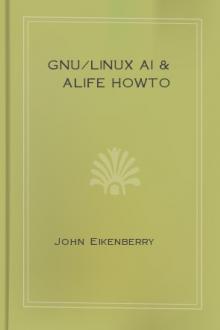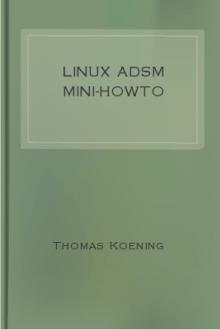GNU/Linux AI & Alife HOWTO by John Eikenberry (easy books to read in english .txt) 📖

- Author: John Eikenberry
- Performer: -
Book online «GNU/Linux AI & Alife HOWTO by John Eikenberry (easy books to read in english .txt) 📖». Author John Eikenberry
� Web site: www.b3e.jussieu.fr/xnbc/
XNBC v8 is a simulation tool for the neuroscientists interested
in simulating biological neural networks using a user friendly
tool.
XNBC is a software package for simulating biological neural
networks.
Four neuron models are available, three phenomenologic models
(xnbc, leaky integrator and conditional burster) and an ion-conductance based model. Inputs to the simulated neurons can be
provided by experimental data stored in files, allowing the
creation of `hybrid” networks.
4. Evolutionary ComputingEvolutionary computing is actually a broad term for a vast array of
programming techniques, including genetic algorithms, complex adaptive
systems, evolutionary programming, etc. The main thrust of all these
techniques is the idea of evolution. The idea that a program can be
written that will evolve toward a certain goal. This goal can be
anything from solving some engineering problem to winning a game.
4.1. EC class/code libraries
These are libraries of code or classes for use in programming within
the evolutionary computation field. They are not meant as stand alone
applications, but rather as tools for building your own applications.
ANNEvolve
� Web site: annevolve.sourceforge.net
A collection of programs using evolved artificial neural
networks to solve a series of problems. The long term goal of
the project is to advance our level of understanding about
simulated evolution as a means to configure and optimize
Artificial Neural Nets (ANNs). The medium term goal is to apply
our methods to a series of interesting problems such as sail
boat piloting and playing the game NIM.
A secondary goal is educational in nature. We attempt to write
our software with ample explanation, not just for the user, but
for the engineer/programmer/scientist who wants to understand
the innermost detail. All of the source code is freely available
to anyone to use without restriction.
All of the ANNEvolve software is implemented in C and Python.
daga
� Web site: garage.cps.msu.edu/software/daga3.2/
daga is an experimental release of a 2-level genetic algorithm
compatible with the GALOPPS GA software. It is a meta-GA which
dynamically evolves a population of GAs to solve a problem
presented to the lower-level GAs. When multiple GAs (with
different operators, parameter settings, etc.) are
simultaneously applied to the same problem, the ones showing
better performance have a higher probability of surviving and
“breeding” to the next macro-generation (i.e., spawning new
“daughter”-GAs with characteristics inherited from the parental
GA or GAs. In this way, we try to encourage good problem-solving strategies to spread to the whole population of GAs.
dgpf
� Web site: dgpf.sourceforge.net
The Distributed Genetic Programming Framework (DGPF) is a
scalable Java environment for heuristic, simulation-based search
algorithms of any kind and Genetic Algorithms in special. We use
the broad foundation of a search algorithms layer to provide a
Genetic Programming system which is able to create Turing-complete code.
It’s under the LGPL license. It allows you to use heuristic
searches like GA and randomized Hill Climbing for any problem
space you like to with just minimal programming effort. Also,
you may distribute all these searches over a network, using the
client/server, the peer-to-peer, or even a client/server+ peer-to-peer hybrid distribution scheme. You also can construct
heterogeneous search algorithms where GA cooperates with Hill
Climbing without changing any code.
Ease
� Web site: www.sprave.com/Ease/Ease.html
Ease - Evolutionary Algorithms Scripting Evironment - is an
extension to the Tcl scripting language, providing commands to
create, modify, and evaluate populations of individuals
represented by real number vectors and/or bit strings.
EO
� Web site: eodev.sourceforge.net
EO is a templates-based, ANSI-C++ compliant evolutionary
computation library. It contains classes for any kind of
evolutionary computation (specially genetic algorithms) you
might come up to. It is component-based, so that if you don’t
find the class you need in it, it is very easy to subclass
existing abstract or concrete class.
FORTRAN GA
� Web site: cuaerospace.com/carroll/ga.html
This program is a FORTRAN version of a genetic algorithm driver.
This code initializes a random sample of individuals with
different parameters to be optimized using the genetic algorithm
approach, i.e. evolution via survival of the fittest. The
selection scheme used is tournament selection with a shuffling
technique for choosing random pairs for mating. The routine
includes binary coding for the individuals, jump mutation, creep
mutation, and the option for single-point or uniform crossover.
Niching (sharing) and an option for the number of children per
pair of parents has been added. More recently, an option for
the use of a micro-GA has been added.
GAlib: Matthew’s Genetic Algorithms Library
� Web Site: lancet.mit.edu/ga/
� Download: lancet.mit.edu/ga/dist/
� Register GAlib at: lancet.mit.edu/ga/Register.html
GAlib contains a set of C++ genetic algorithm objects. The
library includes tools for using genetic algorithms to do
optimization in any C++ program using any representation and
genetic operators. The documentation includes an extensive
overview of how to implement a genetic algorithm as well as
examples illustrating customizations to the GAlib classes.
GALOPPS
� Web site: garage.cps.msu.edu/software/galopps/
� FTP site: garage.cps.msu.edu/pub/GA/galopps/
GALOPPS is a flexible, generic GA, in ‘C’. It was based upon
Goldberg’s Simple Genetic Algorithm (SGA) architecture, in order
to make it easier for users to learn to use and extend.
GALOPPS extends the SGA capabilities several fold:
� (optional) A new Graphical User Interface, based on TCL/TK,
for Unix users, allowing easy running of GALOPPS 3.2 (single
or multiple subpopulations) on one or more processors. GUI
writes/reads “standard” GALOPPS input and master files, and
displays graphical output (during or after run) of user-selected variables.
� 5 selection methods: roulette wheel, stochastic remainder
sampling, tournament selection, stochastic universal
sampling, linear-ranking-then-SUS.
� Random or superuniform initialization of “ordinary” (non-permutation) binary or non-binary chromosomes; random
initialization of permutation-based chromosomes; or user-supplied initialization of arbitrary types of chromosomes.
� Binary or non-binary alphabetic fields on value-based
chromosomes, including different user-definable field sizes.
� 3 crossovers for value-based representations: 1-pt, 2-pt, and
uniform, all of which operate at field boundaries if a non-binary alphabet is used.
� 4 crossovers for order-based reps: PMX, order-based, uniform
order-based, and cycle.
� 4 mutations: fast bitwise, multiple-field, swap and random
sublist scramble.
� Fitness scaling: linear scaling, Boltzmann scaling, sigma
truncation, window scaling, ranking.
� Plus a whole lot more….
GAS
� Web site: starship.skyport.net/crew/gandalf
GAS means “Genetic Algorithms Stuff”.
GAS is freeware.
Purpose of GAS is to explore and exploit artificial evolutions.
Primary implementation language of GAS is Python. The GAS
software package is meant to be a Python framework for applying
genetic algorithms. It contains an example application where it
is tried to breed Python program strings. This special problem
falls into the category of Genetic Programming (GP), and/or
Automatic Programming. Nevertheless, GAS tries to be useful for
other applications of Genetic Algorithms as well.
GAUL
� Web site: gaul.sourceforge.net
� SF project site: sourceforge.net/projects/gaul/
The Genetic Algorithm Utility Library (GAUL) is a flexible
programming library designed to aid development of applications
that require the use of genetic algorithms. Features include:
� Darwinian, Lamarckian or Baldwinian evolutionary schemes.
� Both steady-state and generation-based GAs included.
� The island model of evolution is available.
� Chromosome datatype agnostic. A selection of common
chromosome types are builtin.
� Allows user-defined crossover, mutation, selection,
adaptation and replacement operators.
� Support for multiple, simultaneously evolved,populations.
� Choice of high-level or low-level interface functions.
� Additional, non-GA, optimisation algorithms are builtin for
local optimisation or comparative purposes.
� Trivial to extend using external code via the builtin code
hooks.
� May be driven by, or extended by, powerful S-Lang scripts.
� Support for multiprocessor calculations.
� Written using highly portable C code.
GECO
� FTP site: common-lisp.net/project/geco/
GECO (Genetic Evolution through Combination of Objects), an
extendible object-oriented tool-box for constructing genetic
algorithms (in Lisp). It provides a set of extensible classes
and methods designed for generality. Some simple examples are
also provided to illustrate the intended use.
Genetic
� Web site: ???
� You can get it from the debian repository:
packages.qa.debian.org/g/genetic.html
This is a package for genetic algorythms and AI in Python.
Genetic can typically solve ANY problem that consists to
minimize a function.
It also includes several demos / examples, like the TSP
(traveling saleman problem).
GPdata
� FTP site: ftp.cs.bham.ac.uk/pub/authors/W.B.Langdon/gp-code/
� Documentation (GPdata-icga-95.ps):
cs.ucl.ac.uk/genetic/papers/
GPdata-3.0.tar.gz (C++) contains a version of Andy Singleton’s
GP-Quick version 2.1 which has been extensively altered to
support:
� Indexed memory operation (cf. teller)
� multi tree programs
� Adfs
� parameter changes without recompilation
� populations partitioned into demes
� (A version of) pareto fitness
This ftp site also contains a small C++ program (ntrees.cc) to
calculate the number of different there are of a given length
and given function and terminal set.
gpjpp Genetic Programming in Java
� The code can be found in the tarball linked from “GP and
Othello Java code and READMEs” on this page:
http://www1.cs.columbia.edu/~evs/ml/hw4.html
gpjpp is a Java package I wrote for doing research in genetic
programming. It is a port of the gpc++ kernel written by Adam
Fraser and Thomas Weinbrenner. Included in the package are four
of Koza’s standard examples: the artificial ant, the hopping
lawnmower, symbolic regression, and the boolean multiplexer.
Here is a partial list of its features:
� graphic output of expression trees
� efficient diversity checking
� Koza’s greedy over-selection option for large populations
� extensible GPRun class that encapsulates most details of a
genetic programming test
� more robust and efficient streaming code, with automatic
checkpoint and restart built into the GPRun class
� an explicit complexity limit that can be set on each GP
� additional configuration variables to allow more testing
without recompilation
� support for automatically defined functions (ADFs)
� tournament and fitness proportionate selection
� demetic grouping
� optional steady state population
� subtree crossover
� swap and shrink mutation
jaga
� Web site: cs.felk.cvut.cz/~koutnij/studium/jaga/jaga.html
Simple genetic algorithm package written in Java.
lil-gp
� Web site: garage.cps.msu.edu/software/lil-gp/
� FTP site: garage.cps.msu.edu/pub/GA/lilgp/
patched lil-gp *
� Web site: www.cs.umd.edu/users/seanl/gp/
lil-gp is a generic ‘C’ genetic programming tool. It was written
with a number of goals in mind: speed, ease of use and support
for a number of options including:
� Generic ‘C’ program that runs on UNIX workstations
� Support for multiple population experiments, using arbitrary
and user settable topologies for exchange, for a single
processor (i.e., you can do multiple population gp
experiments on your PC).
� lil-gp manipulates trees of function pointers which are
allocated in single, large memory blocks for speed and to
avoid swapping.
* The patched lil-gp kernel is strongly-typed, with modifications on multithreading, coevolution, and other tweaks and features.
Lithos
� Web site: www.esatclear.ie/~rwallace/lithos.html
Lithos is a stack based evolutionary computation system. Unlike
most EC systems, its representation language is computationally
complete, while also being faster and more compact than the S-expressions used in genetic programming. The version presented
here applies the system to the game of Go, but can be changed to
other problems by simply plugging in a different evaluation
function. ANSI C source code is provided.
Open BEAGLE
� Web site: beagle.gel.ulaval.ca
Open BEAGLE is a C++ evolutionary computation framework. It
provides a high-level software environment to do any kind of
evolutionary computation, with support





Comments (0)